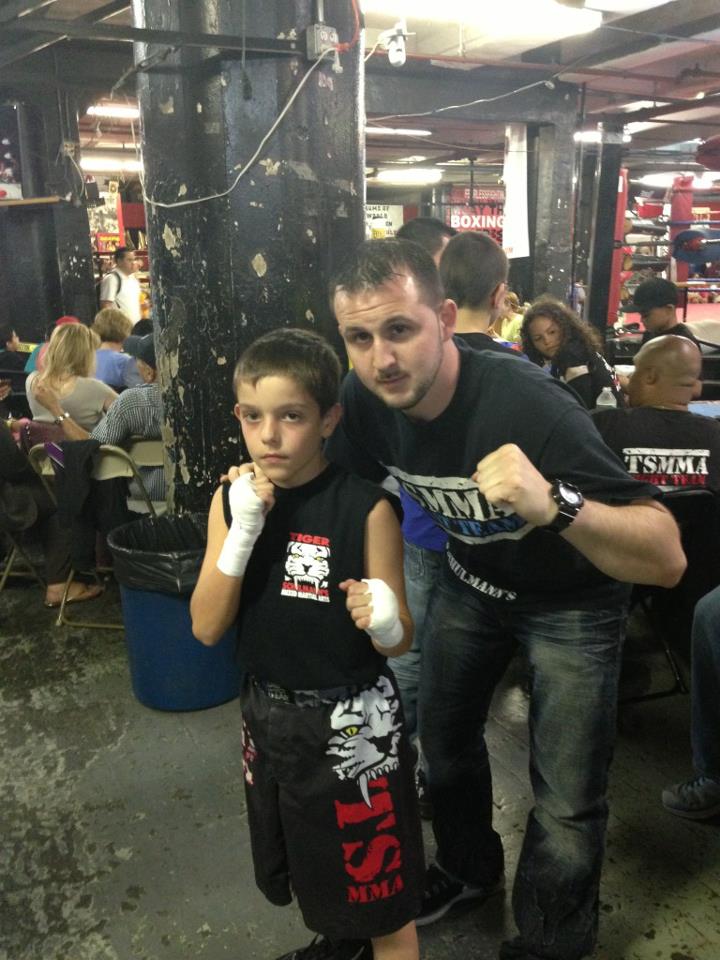Last Updated on July 17, 2013.
Student finds Therapy for life through Tiger Schulmann’s
By: Dana Visi – TSMMA Stamford
At a very early age I was diagnosed with Hemiparisis: a form of Cerebral Palsy: A non-progressive non-contagious neurological condition. It affects muscle strength, coordination, and in my case, causes spasticity (involuntary tightness) of certain muscles. Those with cerebral palsy may have difficulty with walking, speech, hearing and arm/hand coordination due to Contractures (permanently fixed tight muscles and joints) Even though mine is a very mild form, I still dealt with motor delays and learning issues in childhood. The good thing about this is time was on my side and I had plenty of help from others to adapt and develop ways of doing things in a way that worked for me.
To this day I don’t remember much about those early years, but what I do is others repetitively saying how stubborn and brave I was. I have always been fighting something in my life; be it the expectations of medical professionals, my own body or society’s beliefs on what I’m supposed to act like. Being a fighter is not always about getting into the cage and throwing a combination of punches and kicks or executing a choke hold. Sometimes it is simply having the courage to try something new despite any personal obstacles and determination not to complain or give up when it becomes harder than you though it would.
Why I started
When I reached an age and my doctors decided that regular therapy was medically unnecessary my parents made sure I stayed active and signed me up for swimming lessons and other activities where my flexibility and building up my strength were the focus. For several years it didn’t matter I had some type of physical handicap, I was simply part of a team. I remained an active kid playing soccer and intramural sports through local organizations up until my early teens. Around that time I had to undergo surgery to correct a bone growth issue in my leg. After recovery and prolonged therapy there was no way I could perform at the level most others my age were required to. Competitive team sports took a backseat to academics and other types of extracurricular activities.
This was also the time I was becoming very aware and self-conscious about certain mannerisms related to my medical condition that I could not control or explain to others. My quiet nature made it easy for anyone, mostly male peers, to target me for punch lines to their jokes, ignorant remarks, and bullying. I tried to defend myself but realize now this was more of a reaction based in fear rather than an action fueled by confidence and repetition.
A couple years after college I was tired of going to the gym and in need a new athletic activity. I was not overweight, rather out of shape and knew that my flexibility needed improvement. Being a fan of the original Karate Kid, I knew it was going to be some type of martial arts. While shopping with a family member I noticed a place called Tiger Schulmann’s Karate; (yes I said Karate) next to a clothing store. About a week after Christmas I called the school and scheduled my introductory private lesson. It wasn’t until three weeks later I called the school again, this time signing up for an actual class. The current students helped me with my uniform and introduced themselves beforehand. What impacted me the most was having a female instructor “get me” right from the start and hold me to the same standard of everyone else. By the end of that class I had a white belt around my waist and immediately felt welcomed into something that was more than just a place to learn self defense skills.
Obstacles in training
During each class, I deal with balance and coordination issues. To this day I struggle with mountain climbers and spinning back kicks. I’ll grumble and smile all the way through as I slip and stumble but never once have I quit. Early on I also knew I would never be able to safely and effectively perform a cross punch. I was upfront with my original instructors about this and all three discussed alternative moves. They finally decided on the backfist and incorporated it into my drills. I now alternate between a crossing elbow and this when sparring and doing rounds in class and explain to my partners how to hold the pads or their gloves so that they can defend it.
I decided from the beginning to train as a righty because it worked better for me. I’ve gotten so good at this some sparring partners and on lookers are surprised at how well I can hold my own using my left hand for offence and my right hand for defense. Those whose who have trained with me for many years will actually get mad at me for not trying hard or going too slow because they know what I’m capable of.
Due to lack of stability in my right wrist it is physically painful for me to perform a traditional push up on the ground. My first sensei realized this and had me do them against a wall. It wasn’t until Sensei Demetrius took over the Stamford school and asked me if I was able too support myself on my forearm. I said yes and he handed me a Muay-Thai pad. To this day this is how I do my advanced push ups, sometimes even with pops, and this is the modification I will be using when evaluated for my black belt test.
Friendships and Support
Through the years of my training I have learned to be both upfront with the reduced sensation I have in my right arm and respectful of different people’s reactions to working with me because of it. The newer student’s are mostly confused when doing drills with the pads or mitts as sometimes it’s easier for me to work with just one. Certain regular students will still not want to perform a certain grappling drills with me probably not wanting to risk accidentally injuring me. Sometimes me explaining to simply go slower with the move works and others just choose to use another partner. A few students both past and present have come up to me and asked what it is that I have and I had no problem telling them. Others have simply approached me and said they admire me for certain things they see in me. I’ve gotten used to this and use it as part of my motivation to continue training.
Goals and future training
Back when I was a blue belt my original Sensei suggested that I enter something called the C.OC. He explained what it was and suggested I start in grappling. I agreed to participate but felt more confident fighting. Feeling confident I actually made it to the second round that day. I also got a taste of how much faster and stronger my opponents were. At that time I decided I would keep competing until I earned a placement. Six years later, it finally happened. After my moat recent C.O.C and 2nd placement I have decided to take a break from this tournament to focus on my other training goals and challenges.
One of the more difficult periods of my training journey is the one I’m currently in now. I obtained my current rank more than 4 years ago. Many students have been promoted at a faster rate than me. Some are still training and others have left. It took me awhile to accept it would take me longer to move from this level to the next because of the subtle yet critical personal adjustments I had to master in order to become more aggressive and fluid at my advanced level. For this reason I have had to focus much more on my grappling. I have had to get myself caught in submission positions in order to learn how to get out of them. Learning how to hold and finish certain submissions is also something I am constantly working on because of the reduced strength and range of motion I have in my right arm and hand. When the regular way of doing it doesn’t work for me, I’ll ask both Sensei and Joshu how I can perform the move in a way that plays to my strengths rather than my weakness. I also have to learn how to relax my body so that I can transition from one position to the next during free grappling and not gas out. Whenever that moment comes when I get to retire this belt, I know I will have earned it.
Sempai; Black belt
This is my main goal and I will obtain it. For a while I put a timetable on when I thought I’d earn it but I’ve long since thrown it way and focused on the training journey itself.


